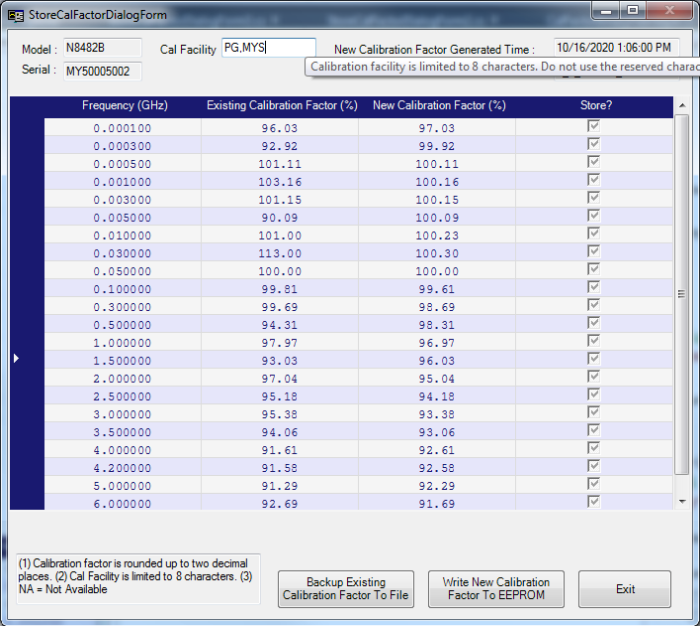
This test does not support the 8480 Series and N8480 Series power sensor with Option CFT because the power sensor does not have a built in EEPROM. For these sensors, refer to Store Calibration Factor.
|
|
This test does not support the 8480 Series and N8480 Series power sensor with Option CFT because the power sensor does not have a built in EEPROM. For these sensors, refer to Store Calibration Factor. |
This test enables you to store the calibration factors generated in the Calibration Factor test to the power sensor (UUT). This test also allows you to save the calibration factors in the UUT to a backup file. You can restore the calibration factor in the backup file to the UUT via the Calibration Factor Read and Write utility.
The E9304A power sensor can only store the calibration factors of the default 24 frequency points to the EEPROM. The E9304A Opt H18 power sensor can only store the calibration factors of the default 37 frequency points to the EEPROM. If you calibrate the E9304A power sensor with additional frequency points, you will not be able to store the additionally generated calibration factors to the EEPROM. However, the calibration factors of the default frequency points are stored to the EEPROM.
For the N8480 Series power sensor, you may store the calibration factors up to 200 frequency points to the EEPROM. If you calibrate the N8480 Series power sensor with additional frequency points exceeding 200, you will be able to select up to 200 frequency points to store to the EEPROM. The calibration factors of the default frequency points are always automatically selected and cannot be deselected. If user selects more than 200 frequency points, a warning will be prompted and only the calibration factors of the default frequency points will be stored to EEPROM.
| Instrument | Recommended product | Alternative product | N8480 Series | E9304A |
| Power Meter | N1914B | N1914A E4419B N1912A |
X | X |

Figure 1. Display for existing and new calibration factors
Click Backup Existing Calibration Factor to File.
This file will be saved to the following directory by default
C:\Documents and Settings\All Users\Application Data\Agilent Technologies\Test Management Environment\{SensorFamily}[1]\{Model#}_{Serial#}. However, you may choose to customize the file name and location to store.
The calibration factors will be stored to the desired file and location.
[1] {SensorFamily} = N848x, E930xx
Click Write New Calibration Factor to EEPROM.
Disconnect the UUT from Channel A of the power meter, and ensure there is no power sensor connected to Channel B of the power meter.
Connect the UUT to Channel A of the power meter.
The calibration factors will be written to the EEPROM of the UUT.
Disconnect the UUT from Channel A of the power meter and ensure there is no power sensor connected to Channel B of the power meter.
Connect the UUT to Channel A of the power meter.
The storing of the calibration factors will be completed. You may choose to run the Calibration Factor Read and Write utility to view the calibration factors stored in the EEPROM of the UUT.
|
|
Steps i and ii are required to disable the temperature update in the EPM power meter which will disturb the write operation. Steps iv and v are required to enable the temperature update back in the EPM power meter. |
If an N1912A or N1914A power meter is used, the storing process will be executed automatically with the UUT connected to channel A of the power meter always. The additional steps required to disable and enable the temperature update in the EPM power meter are not applicable for the P-Series power meter.
